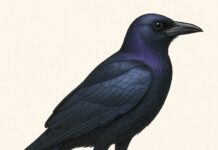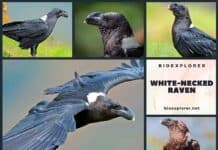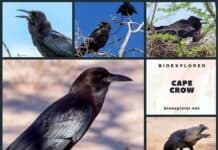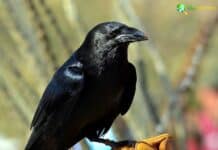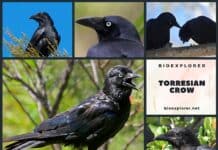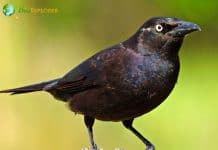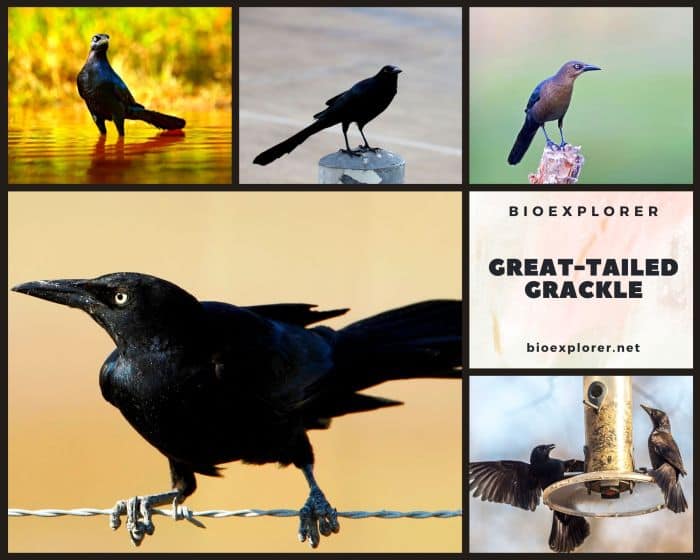
| Animalia | Passeriformes | Icteridae | Quiscalus | Quiscalus mexicanus |
The Great-tailed Grackle (Quiscalus mexicanus) is a large blackbird found across the Americas, recognized for its iridescent black and purple plumage. Male grackles are significantly larger than females, often using long, V-shaped tails during courtship displays. These displays are paired with various vocalizations, making their soundscape unique among songbirds.
Great-tailed Grackles are highly adaptable and opportunistic, able to thrive in urban environments and feed on a varied diet. Despite their increasing population and range, they are sometimes considered pests due to their feeding habits and loud vocalizations.
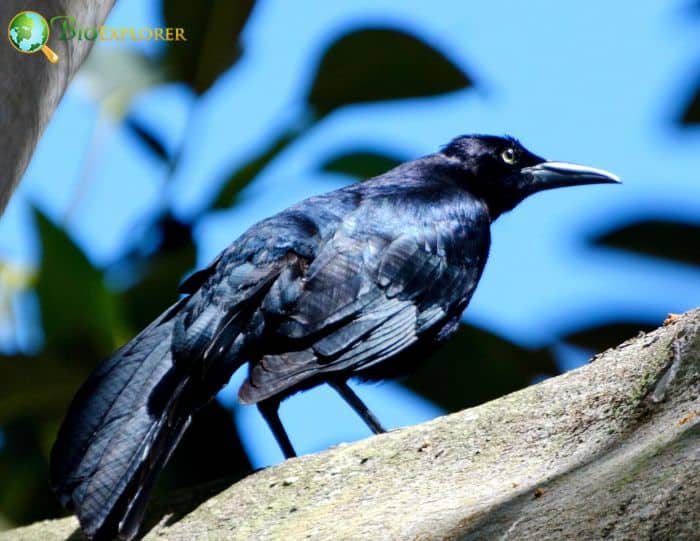
Table of Contents
Great-tailed Grackle Physical Characteristics
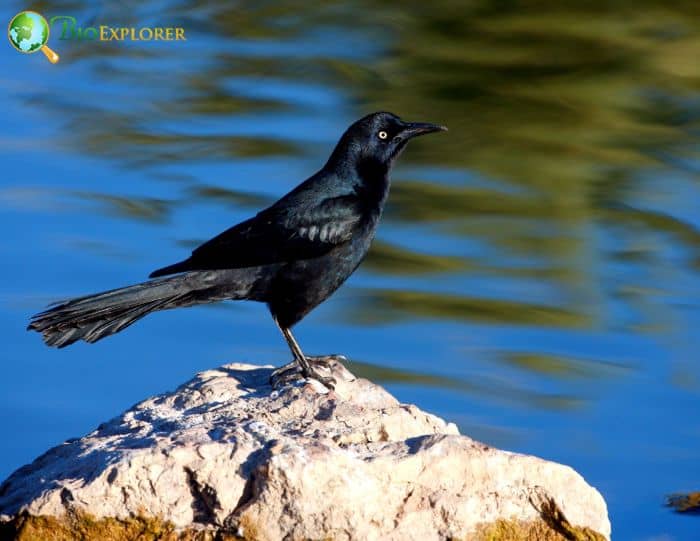
Great-tailed Medium-sized grackles have iridescent black and purple feathers, especially on the tail, which the males display.
- The females have darker tails and wings and are dark brown. Juveniles have brown eyes, compared to the yellow eyes of adult males and females.
- The tails of both males and females are keel-shaped. The male’s tail is sized appropriately for his body.
- The Grackle’s coloring represents the union of the heart and mind in symbolism. It places a strong emphasis on accepting reality and displaying compassion for others.
- This blackbird appears gloomy, but it is a cheerful bird[1].
Great-tailed Grackles communicate with each other
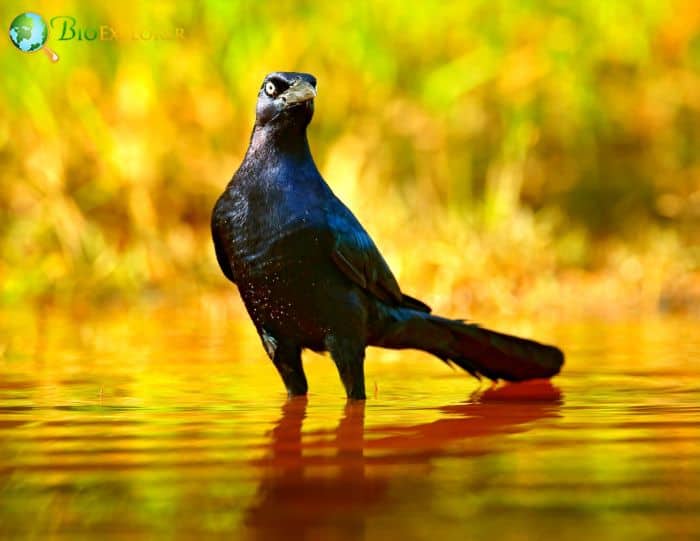
They use a variety of sound modulations as well as specific body gestures like head cocking to communicate. Every situation seems to have its own song. Depending on what is being communicated, the sound’s frequency is determined. They also use tactile and visual communication techniques.
Great-tailed Grackles are highly intelligent
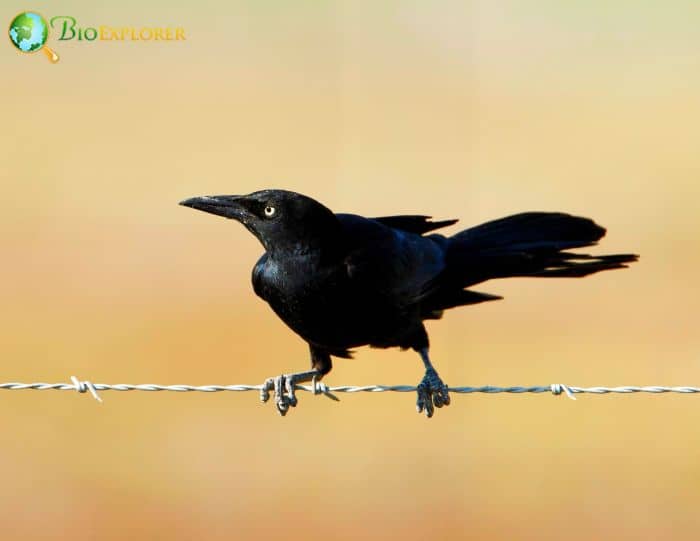
To raise the level of a container of water enough to pluck out a prize, Great-tailed Grackles can complete Aesop’s Fable tests.
Great-tailed Grackles are highly sociable
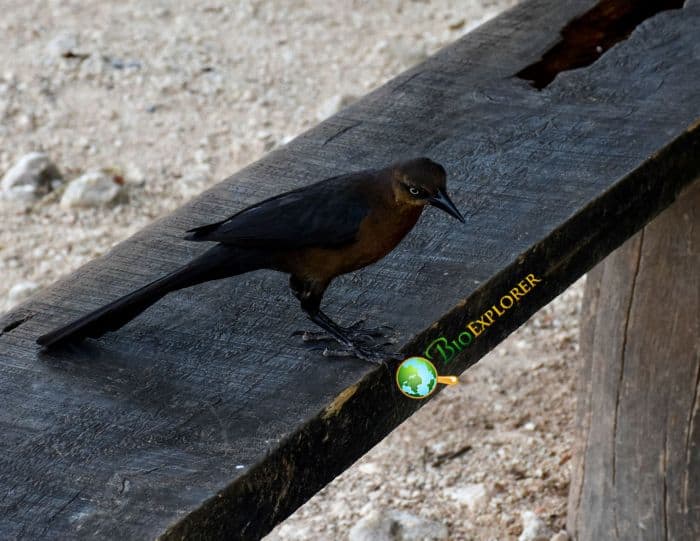
Great-tailed Grackles are extremely sociable birds that gather in large flocks to roost in the evenings. Still, they separate into foraging bands during the day, congregate near eateries, or flit about alone.
- Male grackles exhibit an odd blend of dignity and aggression: While disagreements over territory and affairs of the heart are settled by arching their heads and flashing their nictitating eyelids at one another in an oddly genteel salute, like two swordsmen going through the motions to postpone a duel, disagreements over food can be genuinely nasty.
- During the breeding season, they become obnoxious and puff themselves into large balls of chattering, shrieking feathers to attract potential mates.
- These performances rarely seem to impress female grackles, but then again, female grackles rarely seem to be impressed[2] by anything.
Great-tailed Grackles are omnivores
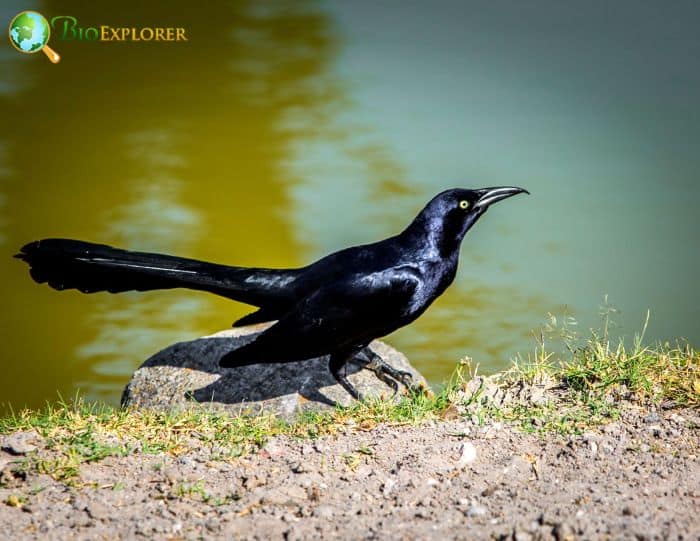
The Great-tailed Grackle is an omnivore with a diverse diet. However, it’s common to see Great-tailed Grackles eating plant matter.
- They also eat fruits, grains like sorghum, oats, maize, and other plant products.
- Animal products make up most of their diet later in the year, such as in the summer and autumn.
- In actuality, females consume up to 80% of animal products. Beetles, grasshoppers, bees, spiders, wasps, worms, snails, moths, and slugs are a few of the creatures they’ll eat.
- Small mammals like shrews and mice, frogs, tadpoles, lizards, fish, and snakes have all been known to be consumed by great-tailed grackles.
- These black songbirds will occasionally even consume eggs and fledglings from other species.
The great-tailed Grackle was once almost exclusively found in South and Central America. Still, due to environmental changes brought on by humans, the birds’ range has expanded to include parts of North America.
What Do Great-tailed Grackles Eat?
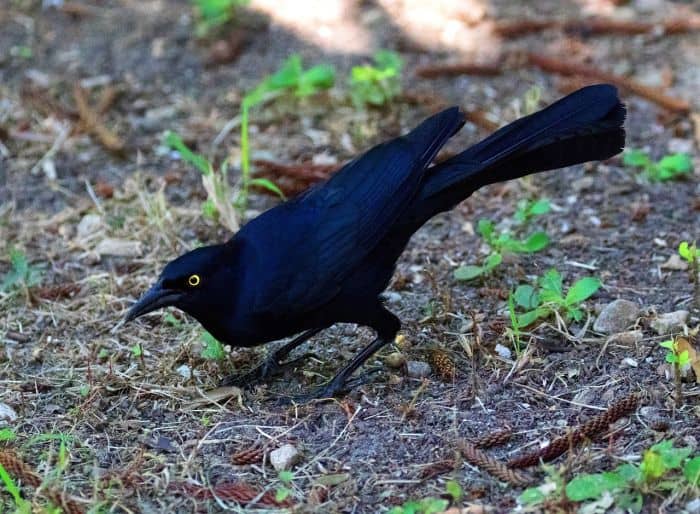
The Great-tailed Grackle nourishes on various organic matters including but not limited to[¶]:
- Poisson Épineux (Actinopterygii)
- Irish Potato (Solanumum tuberosum).
- Hexapoda (Insecta)
- Erect Pricklypear (Opuntiaia stricta).
- Breadnut (Brosimum alicastrum)
- Gia Verde (Casearia arborea).
- White Ramoon (Trophis racemosa).
- Gumbo Limbo (Bursera simaruba).
- Copal (Bursera fagaroides)
- Florida Nectandra (Nectandra coriacea).
- White Milkwood (Tabernaemontana alba).
- Wild Crapemyrtle (Malpighia glabra).
- Quacimmila De Canario (Phoradendron quadrangulare).
- Angelica Tree (Dendropanax arboreus).
- Elliptic-Leaf Velvetseed (Guettarda elliptica).
- Crucero Blanco (Randia laetevirens).
- West Indian Milkberry (Chiococca alba).
- Canilla De Venado (Cupania dentata).
- Pinguin (Bromelia pinguin)
- Coyotillo (Karwinskia humboldtiana)
- Coco Plum (Chrysobalanus icaco).
- Sarsaparilla (Smilax aristolochiifolia)
- Aquatic Soda Apple (Solanum tampicense).
- Amate (Ficus obtusifolia)
- Twinleaf Nightshade (Solanum diphyllum).
- Higuillo De Limon (Piperer amalago).
- White Indigoberry (Randia aculeata).
- Colibrí Cola Rojiza (Amazilia tzacatl).
- Crickets (Orthoptera)
- Borboleta (Lepidoptera)
- Arthropodes (Arthropoda)
- Centipedes (Chilopoda)
- Burrowing Water Beetles (Noteridae).
- Cynipid Gall Wasps (Cynipidae).
- Crickets (Gryllidae)
- Graminées (Poaceae)
- Circular-Seamed Flies (Brachycera)
- Scarab Beetles (Scarabaeidae)
- Ditiques (Dytiscidae)
- Gnats (Diptera)
- Skippers (Hesperiidae)
- Crane Flies (Tipulidae)
- Common Sawflies (Tenthredinidae)
- Cicadellids (Cicadellidae)
- Abelha (Hymenoptera)
- Ants (Formicidae)
- Grasshoppers (Acrididae)
- Wolf Spiders (Lycosidae)
- Black Scavenger Flies (Sepsidae).
- Hornets (Vespidae)
- Corn (Zea mays)
- Ichneumon Flies (Ichneumonidae)
- Pleasing Fungus Beetles (Erotylidae).
- Charançons (Curculionidae)
- Carabes (Carabidae)
- Katydids (Tettigoniidae)
- Araignées (Araneae)
- Darkling Beetles (Tenebrionidae)
- Chrysomèles (Chrysomelidae)
- Caracol (Gastropoda)
- Leaf-Footed Bugs (Coreidae)
- Aphids (Aphididae)
- Chinch Bugs (Lygaeidae)
- Lynx Spiders (Oxyopidae)
- Hawk Moths (Sphingidae)
- Brine Flies (Ephydridae)
- Orbweavers (Araneidae)
- Electric Light Bugs (Belostomatidae).
- Pentatomes (Pentatomidae)
- Beetles (Coleoptera)
- Colubrids (Colubridae)
- Shield-Back Bugs (Scutelleridae)
- Cutworms (Noctuidae)
- Tachinid Flies (Tachinidae)
- Click Beetles (Elateridae)
- Arpenteuses (Geometridae)
- Burrower Bugs (Cydnidae)
- Nécrophores Aquatiques (Hydrophilidae)
- Assassin Bugs (Reduviidae)
- Admirals (Nymphalidae)
- Jumping Spiders (Salticidae)
- Rove Beetles (Staphylinidae)
- Trapdoor Spiders (Ctenizidae)
What Eats Great-tailed Grackles?
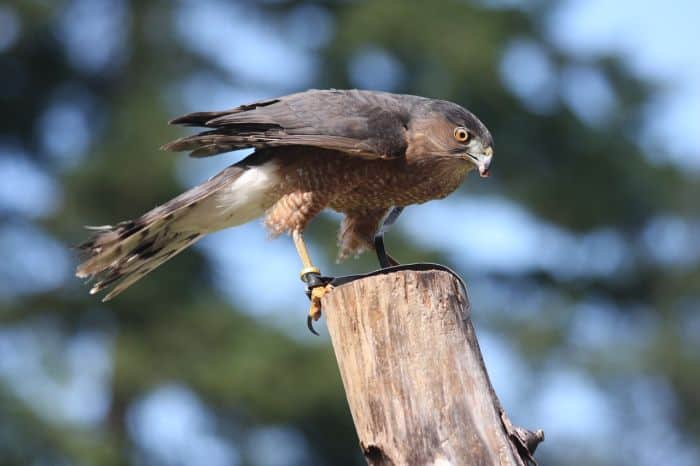
The main predators of Great-tailed Grackles are Cooper’s Hawk (Accipiter cooperii), Águila Cabeza Blanca (Haliaeetus leucocephalus), Aplomado Falcon (Falco femoralis) and Aguililla Cola Roja (Buteo jamaicensis)[§].


